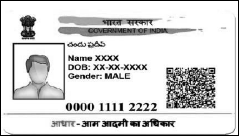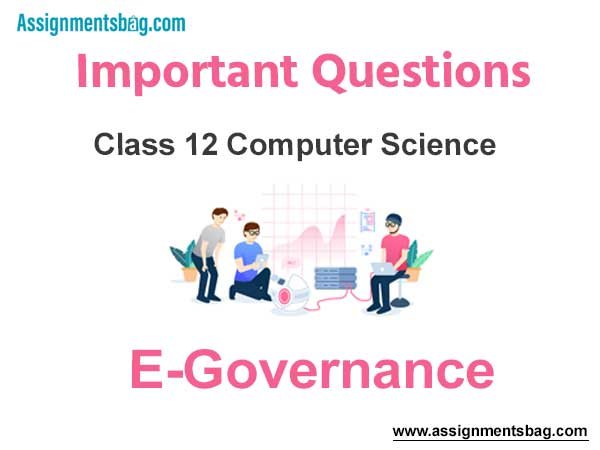Please refer to E Governance (Part-2) Class 12 Computer Science Important Questions with solutions provided below. These questions and answers have been provided for Class 12 Computer science based on the latest syllabus and examination guidelines issued by CBSE, NCERT, and KVS. Students should learn these problem solutions as it will help them to gain more marks in examinations. We have provided Important Questions for Class 12 Computer Science for all chapters in your book. These Board exam questions have been designed by expert teachers of Standard 12.
Class 12 Computer Science Important Questions E Governance (Part-2)
Very Short Answer Type Questions:
Questions: Write the names of different levels of E-governance?
Ans: International, Domestic and National levels
Questions: Write the full form of G2G?
Ans: Govterment to Government
Questions: Name any two information systems?
Ans: MIS (Management Information System), DSS (Decision Support System)
Questions: Write the full form of TPS?
Ans: Transaction Processing System
Questions: Write the full form of UIDAI?
Ans: Unique Identification Authority of India
Short Answer Type Questions.
Questions: Write down any four uses of Aadhar card?
Ans: Here are some key uses of Aadhaar Card:
i. To open a bank account.
ii. To get gas connection and subsidy.
iii. To get a mobile SIM card or telephone connection.
iv. To avail various welfare schemes.
v. As a unique identification document.
Questions: What are the different parts of information system?
Ans: The components of an information system are as follows:
• Hardware: This component monitors, CPUs, keyboards, mice, printers, hard disks etc.
• Software: This component includes all programs that process data using hardware.
• Database: This component is used to store data.
• Network: This part is used to share resources, information and data.
• Procedure: This component includes the methods and processes to obtaine information from data.
Questions: What are the three levels of E-governance? Give detail.
Ans: The different levels of E-Governance system are as under:
1. National Level
2. Domestic Level / State Level
3. International Level
Questions: In brief describe Smart Governance?
Ans: The modern name of e-governance is Smart Governance. ‘Smart’ means attractive and governance means to govern. In simple words, the use of new technology for better planning and better decision making in a democratic system is called smart governance. It deals with ways to improve democratic processes and provide better public services through the use of technology.
Questions: What is the Sewa/Suwidha Kendra? Describe.
Ans: The government has opened many help-desks at different levels (districts, tehsils, blocks, cities, villages) to provide e-services and facilities through e-governance. These support centers are called Sarva Sewa Kendras or Sewa Kendras. These centers provide various e-services to the citizens, such as: issuance of residence certificate,
caste certificate, birth-death certificate, etc.

Long Answer Type Questions
Questions: What are the benefits and limitations of E-Governance?
Ans: The advantages and disadvantages of e-governance are as follows:
Benefits of e-Governance:
1. People can easily get e-governance services online or at their nearest Service or Suwidha Kendras.
2. With the advent of e-governance, government work has also accelerated.
3. E-Governance reduces the cost of documentation.
4. e-Governance has created a transparent environment in the working style of all offices.
5. The concerned officer or employee is liable for any delay in work.
Disadvantages of e-Governance:
1. Uneducated or technically ignorant people cannot avail these services properly.
2. We must have Internet access to use these services.
3. Opening a service center in every village is an expensive task.
4. The Internet cannot be considered completely secure.
Questions: What is information system? Describe its types?
Ans: The types of information systems or information systems are:
• Transaction Processing System: This information system is used by commercial organizations. It deals with sales, payroll, and business reporting. For example: Such systems are used in the banking sectors.
• Decision-Support System: This information system is used by the management of any organization to make decisions. The data collected by management is used to make decisions.
• Executive Information System: This information system is used to efficiently control the functioning of organizations.
• Management Information System: The use of this information system plays an important role in the management of any organization. This system stores all records related to the organization. For example: Punjab Education Department uses MIS to store school, student and staff data.
• Expert systems: These types of systems are used to solve complex problems that are mostly used in science and intelligence departments.

Questions: What is Aadhar card? Describe its characteristics?
Ans: Aadhaar is a unique 12-digit identification card number. This number is issued to Indian citizens by UIDAI (Unique Identification Authority of India.. No two people in India can have the same Aadhaar number. Basic characteristics of aadhar card are as follows:
1. Unique Identity: Aadhaar provides a unique identity to every Indian citizen.
2. Residential document: The complete residential address of the person concerned is printed on it.
3. No expiration date: There is no expiration date of Aadhaar card.
4. Identity Proof: Since the Aadhaar card contains personal and biometric information of the person, it can be used as proof of identity.
5. Online Authentication: Nowadays authentication is done only through Aadhaar card number for various types of online facilities.

Questions: What do you mean by E-Governance? Define its working system?
Ans: E-Governance is a functional system in which governments, citizens and organizations participate in the online facilities and services. All of them perform their activities using the internet in different ways. The workings of e-governance can be explained under the following sections:

1. G2G (Government to Government): This type of e-governance includes online services in which the Central Government and the State Governments share data and information with each other.
2. G2C (Government to Citizen): In this form of e-governance, the government provides services and facilities to its citizens. These services are free or provided at very low cost. Such as: online payment of bills, online payment of income tax etc.
3. G2B (Government to Business): This type of e-governance provides services and facilities to businesses by the government. For example: online services related to online sales, purchase of goods, taxes on goods and subsidies etc.
4. G2E (Government to Employee): In this form of e-governance, the government provides services and facilities to its employees. Such as: online services for pay-bills of employees, maintenance of their service records, departmental transfers etc. For example: iHRMS 5. G2N (Government to NGOs) / Government to NGOs: In this type of e-governance, services and facilities are provided by the government to NGOs. For example: Online registration of NGOs
or societies etc.
Questions: Write down the list of services provided by Sewa/Suvidha Kendra?
Ans: Following are some of the online services and facilities offered by the service centers:
1. Issuance of residency certificate
2. Issuance of Caste Certificate
3. Issuance of birth and death certificate
4. Issuance of income certificate
5. Issuance of Aadhaar Card
6. Issuance of Certificate of Religion
7. Issue copies of registry, mutations.
8. Issuance of Vehicle Registration (Rc. Certificate
9. Filling up old age/widow pension forms
10. Issuance of driving license
11. Submitting electricity, telephone and many other types of bills online.



